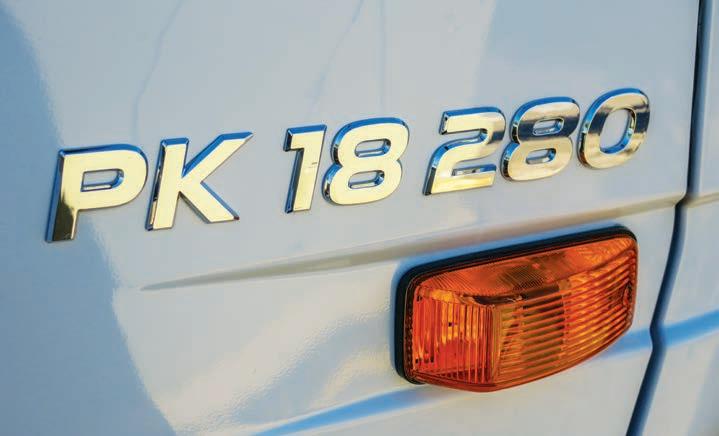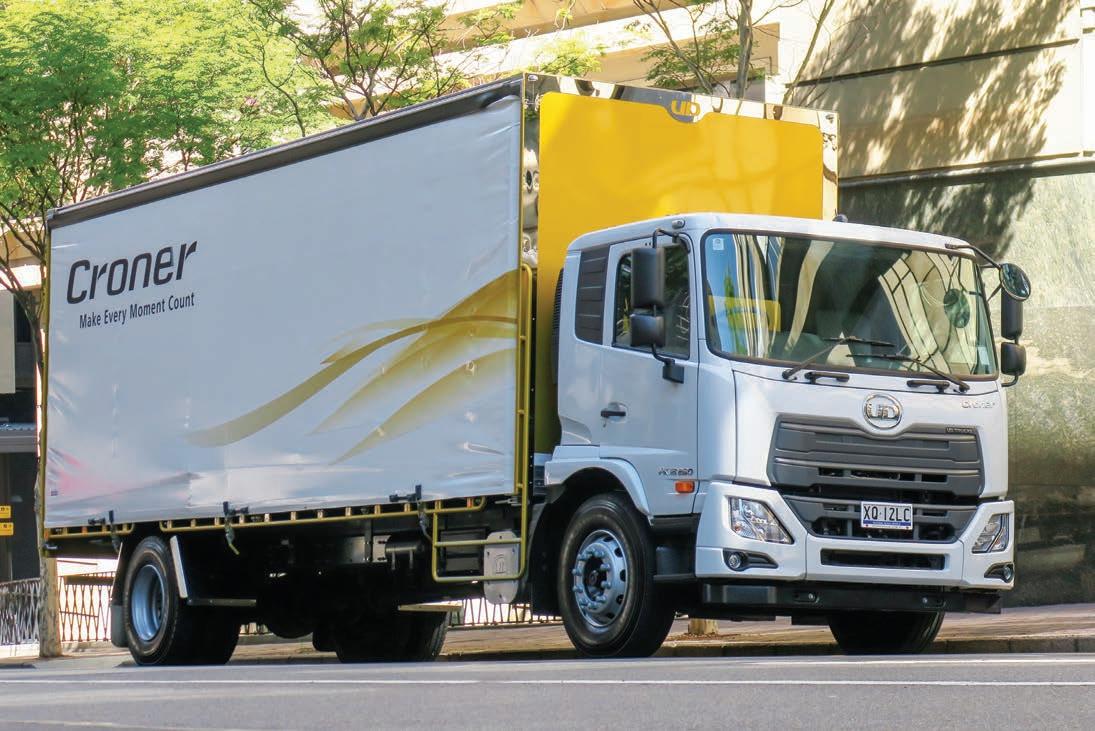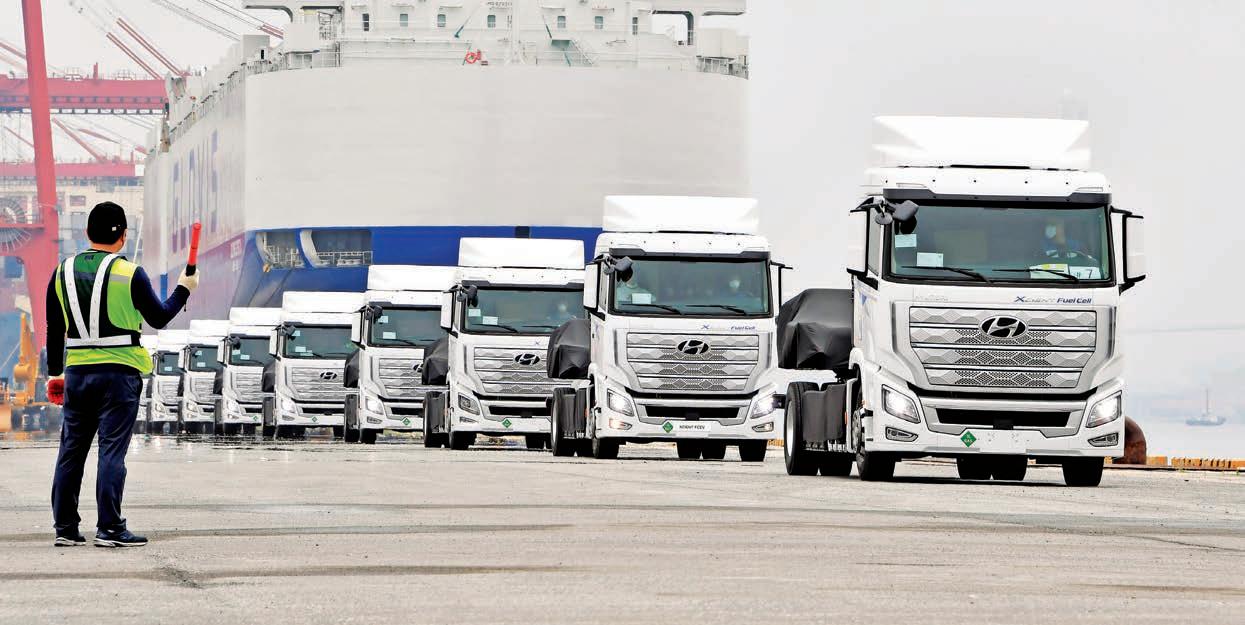
5 minute read
THE OTHER MEDIUM DUTY FROM JAPAN
by Prime Group
UD Trucks are mounting a comeback in the Australian medium duty truck market with a new model, the Croner, leading the charge. Tim Giles takes one out on the roads of Brisbane to assess its potential.
The medium duty truck market in Australia is dominated by the Japanese truck brands, which consistently represent around 90 per cent of truck sales between eight and 16 tonnes GCM. In the last couple of years, UD has reduced sales of trucks in this segment as there was a gap between the last of the Condor models delivered into Australia and the arrival, this year, of the new Croner.
This new model sees the UD brand move away from the lower end of the medium duty sector and push a little further into the lighter end of the heavy duty market. Where the Condor came in with an MK, PK and PD configuration, Croner is simply PK and PD.
Both of these models are, essentially, the same truck. One is configured as a 4x2 and the other as a 6x2. These models’ introduction means that UD Trucks now has a range in Australia which can compete from the 15 tonne GVM Croner four wheeler through the 24 tonne GVM Croner and then on up through the weight scale to include the Quon with 8-litre engine 6x2 and 6x4, the 11-litre engine powered 8x4 rigid and 6x4 rigid and prime mover.
UD seem to have decided to leave the lower GVM end of the medium duty market to the white-hot competition between Isuzu, Hino and Fuso. The company is looking to its traditional core market as a fleet truck in metro and intrastate distribution, plus giving itself the ability to successfully tender for the lucrative and long running Australia Post 4x2 and 6x2 market.
The truck on test for Diesel this time around is the 4x2 Croner with a driveline which is the same throughout the Croner offering, the 280hp (206kW) at 2200rpm 7.7-litre GH8E, which puts out 1,050Nm (774 ft lb) of torque. This proved to be a strong performer in the heavier Quon models tested by Diesel, so it makes easy work of sitting in a 4x2 chassis.
Sitting behind this engine is another proven performer: The Allison 3000 Series six speed fully automatic transmission. If any truck wants to compete in this segment of the market, this has become close to a standard option. In fact, on the Croner, it’s the only option. With 5.57:1 rear axle ratio, this equates to 1800rpm at 100km/h.
Out on the road, the performance of the engine, especially when coupled with the Allison box, makes life so easy for the driver. The pedals are simply stop and go buttons and the driveline just does the rest. When approaching red traffic lights, the driver simply takes the foot off the gas and pulls on the exhaust brake. The transmission does the rest, pushing up the revs to use the retardation.
This kind of set-up is ideal for the kind of work this truck will be asked to do all of its life, racing from traffic light to traffic light to keep up with a busy delivery schedule. The driver can concentrate on all of the other things they need to be aware of and not be changing gears to keep momentum up. Even the worst drivers end up driving this smoothly.
FROM THE DRIVER’S SEAT The basic controls for the driver seem well laid out and pretty simple. There is little clutter of unnecessary switches around the driver. The information
available on the information screen is relatively rudimentary, but this is the smallest and most basic truck sold as part of the Volvo Group.
It does come with cruise control, however, this is controlled on the left hand steering wheel stalk, along with the indicators and lights. On the right, the driver has the exhaust brake stalk along with wiper control.
The control for the Allison is simply a button pad mounted on the engine cover. This is a much better arrangement than that used by some other truck makers with a large stick control where “THE CRONER REMAINS AS AN OUTLIER IN THE WORLD OF VOLVO GROUP TRUCKS, BUT STILL HOLDS ONTO THE KIND OF BASIC INTEGRITY WHICH HAS BEEN ASSOCIATED WITH THE UD BRAND FOR QUITE SOME TIME.”
the gear stick used to be – which unnecessarily impedes cross cab access. That said, the number of times the driver needs to access the controls are minimal, only stopping and starting and then when reversing the truck.
As a basic model, this truck has multiplex electrical system with a CANbus, but it is not the latest generation like that available in the heavier UD and Volvo models. It has a body builder connection module and other items
The Croner uses the 280hp (206kW) at 2200rpm 7.7 litre GH8E engine, which puts out 1,050Nm (774 ft lb) of torque.
which this kind of truck needs, but not nothing like the advanced electronics available elsewhere.
The truck can be connected to the Volvo Dynafleet telematics system and this test truck has a USB socket to the driver’s right into which the driver can plug their identification toggle to enable the system to record their activity.

The same toggle can be used to record across all of the brands in the Volvo Group which use the Dynafleet system.
The entertainment system has the ability to fit four cameras and is built on the Android platform, enabling it to run apps developed for use on the system. The storage provisions in the cabin are regulation, but usually well positioned.

For some reason the Croner does not always come with an integrated seat belt in the driver’s seat. There is also a B pillar fixture available with an adjustable fixture on the pillar. This doesn’t seem to quite fit with the usual Volvo Group safety philosophy elsewhere.
Overall, this truck looks like it can do the job for which it was designed with no problems and give the driver a decent experience while doing so. This part of the market does prefer the more basic truck, probably because the price point is a vital part of the sales strategy in this particularly competitive market sector.
The Croner remains as an outlier in the world of Volvo Group trucks, but still holds onto the kind of basic integrity which has been associated with the UD brand for quite some time. The designers have resisted the temptation to create something with too much sophistication, but also come up with a specification which can do the job, and still have plenty of capacity left in its back pocket.










